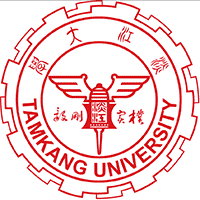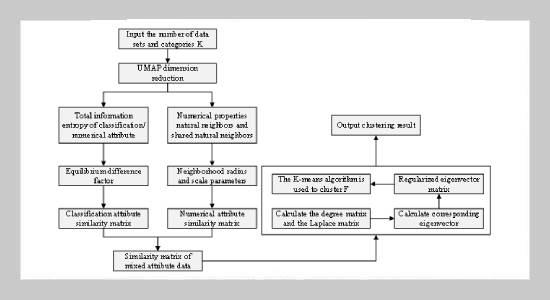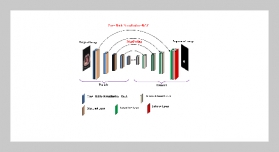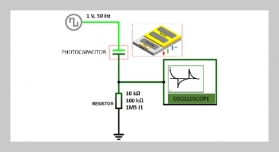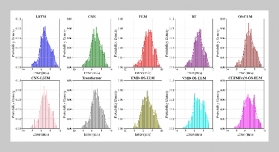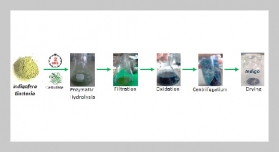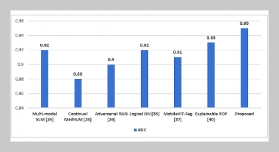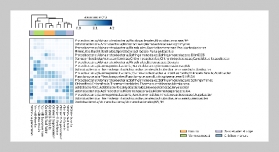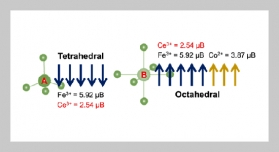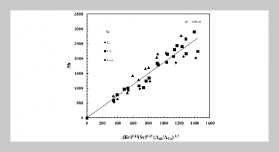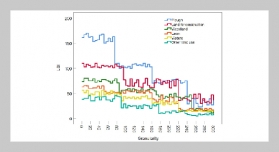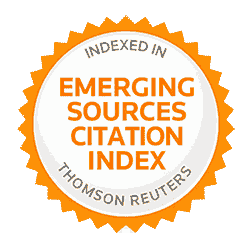- [1] G. J. Oyewole and G. A. Thopil, (2023) “Data clustering: application and trends" Artificial intelligence review 56(7): 6439–6475. DOI: 10.1007/s10462-022 -10325-y.
- [2] J. Cai, J. Hao, H. Yang, X. Zhao, and Y. Yang, (2023) “Areview on semi-supervised clustering" Information Sciences 632: 164–200. DOI: 10.1016/j.ins.2023.02.088.
- [3] I. Barrio-Hernandez, J. Yeo, J. Jänes, M. Mirdita, C. L. Gilchrist, T. Wein, M. Varadi, S. Velankar, P. Beltrao, and M.Steinegger, (2023) “Clustering predicted structures at the scale of the known protein universe" Nature 622(7983): 637–645. DOI: 10.1038/s41586-023-06510-w.
- [4] K.Taha,(2023)“Semi-supervisedandun-supervised clustering: A review and experimental evaluation" Information Systems 114: 102178. DOI: 10.1016/j.is.2023.102178.
- [5] S. Yin, H. Li, D. Liu, and S. Karim, (2020) “Active contour modal based on density-oriented BIRCH clustering method for medical image segmentation" Multimedia tools and applications 79(41): 31049–31068. DOI: 10.1007/s11042-020-09640-9.
- [6] S. M. Miraftabzadeh, C. G. Colombo, M. Longo, and F. Foiadelli, (2023) “K-means and alternative clustering methods in modern power systems" Ieee Access 11: 119596–119633. DOI: 10.1109/ACCESS.2023.3327640.
- [7] Y. Liu, X. Yang, S. Zhou, X. Liu, S. Wang, K. Liang, W. Tu, and L. Li, (2023) “Simple contrastive graph clustering" IEEE Transactions on Neural Networks and Learning Systems 35(10): 13789–13800. DOI: 10.1109/TNNLS.2023.3271871.
- [8] A. M.Bagirov, R. M. Aliguliyev, and N. Sultanova, (2023) “Finding compact and well-separated clusters: Clustering using silhouette coefficients" Pattern Recognition 135: 109144. DOI: 10.1016/j.patcog.2022.109144.
- [9] J.Yu,H.Li,andD.Liu,(2020) “Modified immuneevolutionary algorithm for medical data clustering and feature extraction under cloud computing environment" Journal of healthcare engineering 2020(1): 1051394. DOI: 10.1155/2020/1051394.
- [10] J. Xie, W. Kong, S. Xia, G. Wang, and X. Gao, (2023) “Anefficient spectral clustering algorithm based on granular-ball" IEEE Transactions on Knowledge and Data Engineering 35(9): 9743–9753. DOI: 10.1109/TKDE.2023.3249475.
- [11] S. Forouzandeh, K. Berahmand, R. Sheikhpour, and Y. Li, (2023) “A new method for recommendation based on embedding spectral clustering in heterogeneous networks (RESCHet)" Expert Systems with Applications 231: 120699. DOI: 10.1016/j.eswa.2023.120699.
- [12] C. Gao, W. Chen, F. Nie, W. Yu, and Z. Wang, (2024) “Spectral clustering with linear embedding: A discrete clustering method for large-scale data" Pattern Recognition 151: 110396. DOI: 10.1016/j.patcog.2024.110396.
- [13] J. H. Priyanka and N. Parveen, (2024) “DeepSkillNER: an automatic screening and ranking of resumes using hybrid deep learning and enhanced spectral clustering approach" Multimedia Tools and Applications 83(16): 47503–47530. DOI: 10.1007/s11042-023-17264-y.
- [14] Q. Zheng, (2024) “Flexible and parameter-free graph learning for multi-view spectral clustering" IEEE Trans actions on Circuits and Systems for Video Technology 34(9): 8966–8971. DOI: 10.1109/TCSVT.2024.3382761.
- [15] C. Wang, Z.Gu,and J.-M.Wei,(2024)“Spectralclustering and embedding with inter-class topology-preserving" Knowledge-Based Systems 284: 111278. DOI: 10.1016/j.knosys.2023.111278.
- [16] Y. Sun, S. Yin, H. Li, L. Teng, and S. Karim, (2019) “GPOGC:Gaussianpigeon-oriented graph clustering algorithm for social networks cluster" IEEE Access 7: 99254 99262. DOI: 10.1109/ACCESS.2019.2926816.
- [17] Y. Liu, D. Chen, S. Fu, P. T. Mathiopoulos, M. Sui, J. Na, andJ. Peethambaran, (2024) “Segmentation of individual tree points by combining marker-controlled water shed segmentation and spectral clustering optimization" Remote Sensing 16(4): 610. DOI: 10.3390/rs16040610.
- [18] K. P. Kumar, B. H. Kumar, and A. Bhuvanesh, (2024) “Spectral clustering algorithm based web mining and quadratic support vector machine for learning style pre diction in E-learning platform" Measurement: Sensors 31: 100962. DOI: 10.1016/j.measen.2023.100962.
- [19] T. Yang, C.-D. Wang, J. Guo, X. Li, M.-S. Chen, S. Dang, and H. Chen, (2025) “Triplets-based large-scale multi-view spectral clustering" Information Fusion 121: 103134. DOI: 10.1016/j.inffus.2025.103134.
- [20] J. Deng, D. Huang, Y. Ding, Y. Zhu, B. Jing, and B. Zhang, (2024) “Subsampling spectral clustering for stochastic block models in large-scale networks" Computational Statistics & Data Analysis 189: 107835. DOI: 10.1016/j.csda.2023.107835.
- [21] X. Peng, L. Zhang, and Z. Yi. “Scalable sparse sub space clustering”. In: Proceedings of the IEEE conference on computer vision and pattern recognition. 2013, 430 437. DOI: 10.1109/CVPR.2013.62.
- [22] W. Wang, Z. Jiang, J. Zhang, and L. Yang. “Load swing suppression and path tracking control of the quadrotor with non-centroid suspended payload in windy environments”. In: 2023 42nd Chinese Control Conference (CCC). IEEE. 2023, 750–757. DOI: 10.23919/CCC58697.2023.10240238.
- [23] Z. Wu, M. Yin, Y. Zhou, X. Fang, and S. Xie, (2018) “Robust spectral subspace clustering based on least square regression" Neural processing letters 48(3): 1359 1372. DOI: 10.1007/s11063-017-9726-z.
- [24] P. O. Brown, M. C. Chiang, S. Guo, Y. Jin, C. K. Leung, E. L. Murray, A. G. Pazdor, and A. Cuzzocrea. “Mahalanobis distance based k-means clustering”. In: International Conference on Big Data Analytics and Knowledge Discovery. Springer. 2022, 256–262. DOI: 10.1007/978-3-031-12670-3_23.
- [25] C. Hou, L.-L. Zeng, and D. Hu, (2018) “Safe classification with augmented features" IEEE transactions on pattern analysis and machine intelligence 41(9): 2176–2192. DOI: 10.1109/TPAMI.2018.2849378.
- [26] S. S. Salleh, N. A. A. Aziz, D. Mohamad, and M. Omar, (2012) “Combining mahalanobis and jaccard distance to overcome similarity measurement constriction on geometrical shapes" International Journal of Computer Science Issues (IJCSI) 9(4): 124. DOI: 10.1109/uksim.2011.67.
- [27] W. Zhou, L. Wang, X. Han, M. Parmar, and M. Li, (2023) “A novel density deviation multi-peaks automatic clustering algorithm" Complex & Intelligent Systems 9(1): 177–211. DOI: 10.1007/s40747-022-00798-3.
- [28] J. Zhao, G. Wang, J.-S. Pan, T. Fan, and I. Lee, (2023) “Density peaks clustering algorithm based on fuzzy and weighted shared neighbor for uneven density datasets" Pattern Recognition 139: 109406. DOI: 10.1016/j.patcog.2023.109406.
- [29] J. Healy and L. McInnes, (2024) “Uniform manifold ap proximation and projection" Nature Reviews Methods Primers 4(1): 82. DOI: 10.1038/s43586-024-00363-x.
- [30] A. Li, S. Mei, C. Feng, T. Gao, and H. Huang, (2025) “Deep spectral clustering network for incomplete multiview clustering" Engineering Applications of Artificial Intelligence 148: 110387. DOI: 10.1016/j. engappai.2025.110387.
- [31] H. Zhou, Z. Wang, H. Chen, and X. Wang, (2024) “A novel spectral clustering algorithm based on neighbor relation and Gaussian kernel function with only one parameter" Soft Computing 28(2): 981–989. DOI: 10.1007/ s00500-023-09309-z.
- [32] Q. Yu, L. Jia, Y. Shao, J. He, J. Wang, X. Yuan, M. Huan, and Y. Yang, (2025) “A local adaptive fuzzy spectral clustering method for robust and practical clustering" Scientific Reports 15(1): 7833. DOI: 10.1038/s41598 025-91812-4.
- [33] A. Y. Zhang and H. Y. Zhou, (2024) “Leave-one-out singular subspace perturbation analysis for spectral clustering" The Annals of Statistics 52(5): 2004–2033. DOI: 10.1214/24-aos2418.
- [34] A. K. Moorthy, V. V. Saradhi, and B. Prasad, (2025) “Ensuring Fairness in Spectral Clustering via Disparate Impact-Based Graph Construction" IEEE Transactions on Artificial Intelligence 6(8): 2342–2352. DOI: 10.1109/TAI.2025.3545800.
